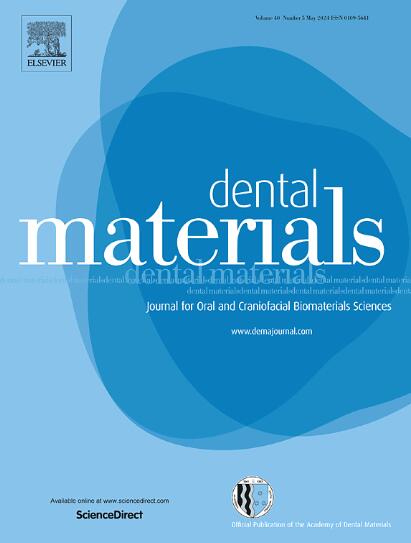具有胆固醇甲基丙烯酸酯有机基质的实验性树脂复合材料的特性 - 第 2 部分。
IF 4.6
1区 医学
Q1 DENTISTRY, ORAL SURGERY & MEDICINE
引用次数: 0
摘要
研究目的本研究旨在评估实验树脂中胆固醇甲基丙烯酸酯(CM)的转化率(%)、弯曲强度(兆帕)、弹性模量(GPa)、压缩强度(兆帕)、努氏显微硬度(KHN)、凝胶后收缩率(%)以及理想浓度的预测:对四种配方(F)进行了处理:F1,对照组(0 % CM);F2(15 % CM);F3(19.8 % CM)和 F4(30 % CM)。使用 Statistica™ 软件测定 Bis-GMA 和 CM 百分比。转换度测试采用拉曼光谱。在测试抗折强度、弹性模量和抗压强度时,使用了万能试验机。努氏显微硬度测试在每个样品上都做了五个压痕。凝胶后收缩率采用应变计法测定。Statistica™ 软件处理了本研究获得的所有数据。对结果进行了单因素方差分析和 Tukey 后检验(α = 0.05):在转化率、弹性模量和凝胶后收缩率方面,F2(15% CM)和 F3(19.8% CM)的性能更好。在努氏显微硬度方面,F2(15 % CM)、F3(19.8 % CM)和 F4(30 % CM)的数值高于 F1(0 % CM)。在抗折强度方面,F1(0 % CM)和 F3(19.8 % CM)的数值相似,F4 的数值最低;在抗压强度方面,F1(0 % CM)的数值最高。就混合物设计分析数据而言,CM 浓度≤ 25 % 的结果会更好:添加浓度低于 30 % 的 CM 有助于显著提高转化率、微硬度值、弹性模量和减少凝胶后收缩。本文章由计算机程序翻译,如有差异,请以英文原文为准。
Characterization of experimental resin composites with cholesteryl methacrylate organic matrix – Part 2
Objective
The aim of this study was to evaluate the degree of conversion (%), flexural strength (MPa), elastic modulus (GPa), compressive strength (MPa), Knoop microhardness (KHN), post-gel shrinkage (%) and prediction of ideal concentration of cholesteryl methacrylate (CM) in experimental resins.
Methods
Four formulations were manipulated (F): F1, control group, (0 % CM); F2 (15 % CM); F3 (19.8 % CM) and F4 (30 % CM). Bis-GMA and CM percentages were determined using Statistica™ software. For the degree of conversion test, Raman spectroscopy was used. To testing flexural strength, elastic modulus and compressive strength, a universal testing machine was used. For the Knoop microhardness test five indentations were made in each sample. Post-gel shrinkage was determined using the strain gauge method. Statistica™ software processed all data obtained in this study. Results were submitted to one-way ANOVA and Tukey's post hoc tests (α = 0.05).
Results
Better performance was observed for F2 (15 % CM) and F3 (19,8 % CM) for degree of conversion, elastic modulus and post-gel shrinkage. For Knoop microhardness F2 (15 % CM), F3 (19,8 % CM) and F4 (30 % CM) showed higher values than F1 (0 % CM). For flexural strength F1 (0 % CM) and F3 (19,8 %) were similar and F4 showed the lowest values and for compressive strength F1 (0 % CM) showed the highest values. For mixture designs analysis data, concentrations ≤ 25 % of CM would provide better results.
Significance
Addition of CM at concentrations lower than 30 % contributed to a significant increase in the degree of conversion, microhardness values, elastic modulus and reduction of post-gel shrinkage.
求助全文
通过发布文献求助,成功后即可免费获取论文全文。
去求助
来源期刊

Dental Materials
工程技术-材料科学:生物材料
CiteScore
9.80
自引率
10.00%
发文量
290
审稿时长
67 days
期刊介绍:
Dental Materials publishes original research, review articles, and short communications.
Academy of Dental Materials members click here to register for free access to Dental Materials online.
The principal aim of Dental Materials is to promote rapid communication of scientific information between academia, industry, and the dental practitioner. Original Manuscripts on clinical and laboratory research of basic and applied character which focus on the properties or performance of dental materials or the reaction of host tissues to materials are given priority publication. Other acceptable topics include application technology in clinical dentistry and dental laboratory technology.
Comprehensive reviews and editorial commentaries on pertinent subjects will be considered.
 求助内容:
求助内容: 应助结果提醒方式:
应助结果提醒方式:


